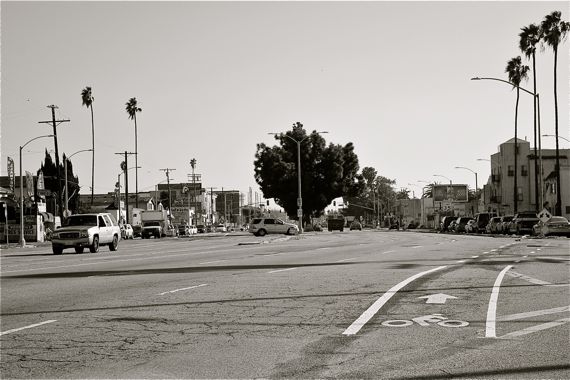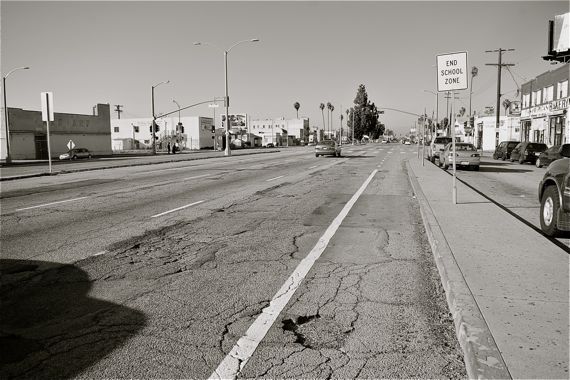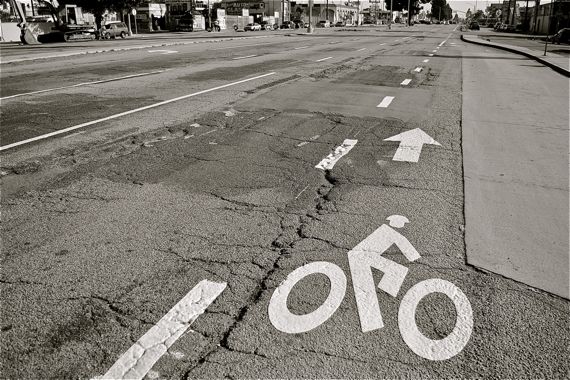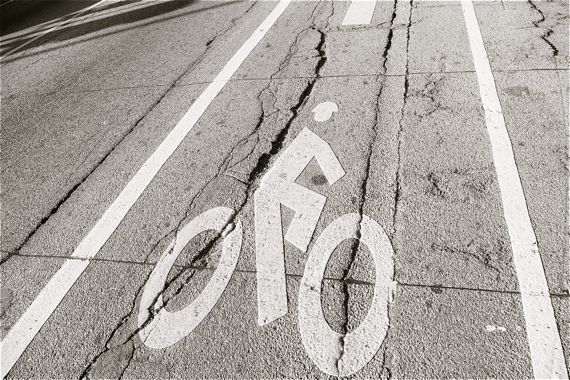New Bike Lanes on Vermont: One Small Step Forward Where Three or Four Big Steps Are Needed
2:17 PM PST on March 1, 2013
As a cyclist, I do my best to avoid Vermont Ave. like the plague.
It's always busy, it's an important bus corridor, and much of it is in lousy, bone-rattling condition, especially in South L.A. Moreover, there are few spots where you feel like you have a comfortable cushion between you and drivers in a hurry that hate being on Vermont as much as you do. There might only be two blocks between Exposition Blvd. and MLK, for example, but that stretch is so narrow that it feels like you are running a gauntlet. And, much to the ire of drivers at rush hour, a cyclist has to take the full lane because because of the deep potholes on the southbound side and impressive array of asphalt moguls that run along the gutter on both sides for that whole stretch.
South of Gage, where the road widens to three lanes and a separated business lane, speeds pick up just as the conditions worsen for everyone. During the day, a cyclist can generally manage to avoid potholes, cracks, and random palm frond debris while dodging cars. Things get dicier at night, however, when it is harder to see the depth of the cracks or the height of the moguls and you are more likely to be unexpectedly thrown off balance, possibly into traffic.
Yet, because I'm usually running late, every Wednesday evening at rush hour, I find myself reluctantly sprinting the 140 or so blocks of Vermont that comprise the shortest distance between my apartment and the YMCA at Century Blvd., where I help mentor South L.A. youth from the Youth Action Council. Obviously, I haven't died yet and am still in once piece, so I've managed to get there safely. But, of all the routes I do bike, it is probably the one where my mortality is front and center in my mind for most of the ride.
Not being one who is particularly good at keeping up with bike-lane implementation schedules, the construction of new lanes along Vermont caught me by surprise a few weeks ago. I couldn't decide if it was a good surprise or a bad one. I would NEVER say no to a bike lane, of course. They legitimize cyclists' presence in the streets and make it clear to drivers that there is space for everyone. But, it was also a bit like unexpectedly finding that last hard-boiled Easter egg hidden behind a curtain several weeks after Easter: you're thrilled to see it, but you may not want to eat it.
The new lanes stretch the approximately 17 blocks between Gage and 79th.
They are helpful, as stated above, in the sense that they make clear that there is ample space for both cyclists and drivers. I can attest that I definitely felt more relaxed riding within the space demarcated for my benefit and more vulnerable when lane-less.
But, I am an experienced cyclist with 20 years of riding in seriously formidable traffic conditions under my belt. I'm not sure that unprotected lanes in abysmal condition will offer much of an incentive to novice riders, experienced riders who tend to opt for sidewalks or the quieter (but also abysmally paved) business lanes, or recreational cyclists, especially those that want to ride with their families.
"You're the only one I've seen out there," Trina Greene, the Peace over Violence staff member in charge of the Youth Action Council told me the other day. "Everybody else is still on the sidewalk."
I haven't seen anyone else chomping at the bit to test the lanes out, either, unfortunately. But it is easy to guess why.
For one, dodging the potholes and wheel-grabbing cracks that liberally populate the narrow bike lanes requires both concentration and strong nerves, as you must sometimes edge toward fast moving traffic or mogul-infested curbs to avoid them.
Every other block also seems to have a bus stop, which means that you are often playing leapfrog with buses.
I have to give L.A. bus drivers credit -- they have a tough job and many do their best to co-exist as amicably as possible with the cyclists they must share curbside space with. But, having to constantly swing out into traffic around stopped buses could be incredibly daunting for novice cyclists or someone with a child in tow.

And, finally, there are the weird dead spaces where the dividers between the main lanes and the business lane disappear and you feel uncomfortably exposed in a sea of pock-marked asphalt. Attempts to provide painted guidance (see below) do mitigate some of the feelings of abandonment and vulnerability one might experience in those zones, but I can't help but think we have evolved to be more creative with design than this.
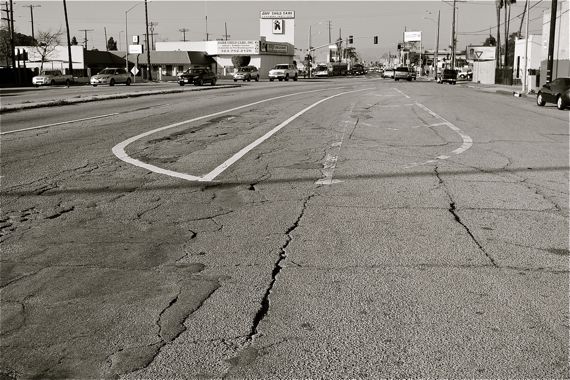
Even sections of Vermont where bike lanes were put in last year (at least, on the northbound side; some of the county-controlled southbound side has sharrows) between the Green Line station and 88th are in bad enough condition to serve as a possible deterrent to those that considered multi-modaling their way around the area.
Although, I did unexpectedly see a horse using the bike lane at the intersection with 98th one night, so at least someone is getting some use out of it.
As I said before, I would never say no to a bike lane. They are desperately needed along key corridors like Vermont and I am grateful they are there, imperfect as they may be.
At the same time, they aren't much good if they seem more hazardous than safe to a cyclist. Cracks, holes, and buses aside, I can see no reason why a cyclist would risk riding with fast-moving traffic when they can ride in what is essentially a protected lane (the business lane) for much of their commute in the area south of Gage.
In a way, Vermont is a huge blank canvas: as many as eight total lanes south of Gage; center dividers that are sparsely decorated with trees and sad patches of grass; treeless islands that serve as bus stops but which are only sometimes ADA compliant and provide little in the way of shelter for those waiting for buses. Private ownership of the numerous vacant lots may hinder redevelopment of some aspects of the corridor, but the street itself is something we have control over. Repaved, reimagined, and restructured, it could be a much healthier and more pleasant corridor for everyone and a catalyst for growth a struggling community. It is listed as a priority street in the South L.A. Community Plan, and sections of it (like the Vermont/Manchester area) are singled out for the focus of redevelopment efforts, but it isn't clear yet what that means for the future of the length of the corridor.
Similarly, LA/2B (the effort to solicit community input on the Mobility Element of the General Plan for L.A.) lists this section of Vermont, part of the Backbone Network, as a candidate for future Transit and Bicycle Enhancements. Basic improvements to the corridor could include right-of-way infrastructure improvements and traffic diversion treatments, such as buffered or protected bicycle facilities. If there was enough support for these and other treatments, according to the website, we could also possibly see enhancements to bike lanes in the form of:
- Wide Bicycle Lane with Additional Pavement Markings (9.1 Technical Design Handbook);
- Raised Bicycle Lanes (9.12 TDH);
- Cycle Tracks-Protected Bicycle Lanes (9.13 TDH); or
- Dedicated Bicycle Lane w/Bus Lane (3.5 TDH may be modified to have a curb-adjacent bicycle lane with passenger crossing markings and boarding platform).
In addition, an assortment of additional treatments could include:
All of these are only possibilities at the moment. Vermont is only a candidate street for enhancements -- nothing is set in stone. So, if some of these possibilities sound good to you, please check out LA/2B's website and vote for the implementation of enhancements in this and other areas of the city. The survey itself is a bit unwieldy, as you must vote on streets you may not know much about and it helps a lot if you know something about the 2010 Bike Plan. That said, it does allow for you to comment on the specifics of the streets where you would like to see changes, which may be the most beneficial source of information for planners. So, please, check it out and leave your comments in favor of a better bike corridor there. You've got 30 days left to add your two cents.
Have you ridden the new lanes yet? Or have reasons why you prefer not to? Share your thoughts below.
*Thanks also to Dennis Hindman for reminding me to check LA/2B's updates regarding Vermont Ave.
Sahra is Communities Editor for Streetsblog L.A., covering the intersection of mobility with race, class, history, representation, policing, housing, health, culture, community, and access to the public space in Boyle Heights and South Central Los Angeles.
Stay in touch
Sign up for our free newsletter
More from Streetsblog Los Angeles
Metro Board Funds Free Student Transit Pass Program through July 2025
Metro student free passes funded another year - plus other updates from today's Metro board meeting
Eyes on the Street: New Lincoln Park Avenue Bike Lanes
The recently installed 1.25-mile long bikeway spans Lincoln Park Avenue, Flora Avenue, and Sierra Street - it's arguably the first new bike facility of the Measure HLA era
